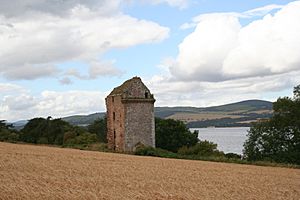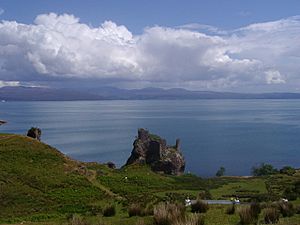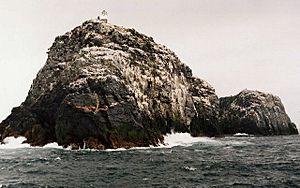Donald Monro (priest) facts for kids

Donald Monro was an important Scottish church leader who lived in the 1500s. He was known as the "Dean of the Isles." He wrote a very valuable book describing the many islands off the west coast of Scotland, called the Hebrides. This book helps us understand what life was like in Scotland centuries ago.
Contents
Who Was Donald Monro?
Donald Monro was born in the early 1500s. He was the oldest of six sons. His father was Alexander Munro of Kiltearn. His mother was Janet Maclean. Donald's grandfather, George Munro, was a chief of the Clan Munro. His mother's father, Farquhar MacLean, was a Bishop of the Isles. Later, Donald's uncle, Roderick MacLean, also became a bishop.
Donald Monro's Life and Work
Donald Monro became a vicar, which is a type of church leader, in 1526. He worked in places like Snizort and Raasay. He noted that while some islands belonged to the Bishop of the Isles, they were often controlled by local clans. This was a difficult time in the Highlands and Islands. People were trying to bring back the old "Lordship of the Isles" rule.
The church in the Isles was not very rich. Even though Monro listed many islands as belonging to the Bishop, it was hard to collect money from them. Around 1549, he became the Archdeacon of the Isles. This was another important church position.

Donald Monro called himself "Sir Donald." This was a common title for priests who had not gone to university. He also called himself "High Dean of the Isles." He had a lot of influence. However, the Scottish Reformation was happening. This was a big change in how the church was run in Scotland.
Monro was first a Roman Catholic. But after the Reformation in 1560, he joined the Presbyterian Church of Scotland. He became a minister in Kiltearn, Alness, and Lemlair. In 1563, he was chosen to help create new churches in Ross. He kept this job for 12 years. He was sometimes criticized for not speaking Gaelic well enough.
People believe he lived at Castle Craig on the Black Isle. He would cross the Cromarty Firth to do his church duties. Around 1568, he may have been in trouble for supporting Mary, Queen of Scots. But by 1570, he was back in his position. The last record of him is from 1574. He likely died by 1576. He never married. His writings are his main legacy.
Did Donald Monro Speak Gaelic?
Some people thought Donald Monro wasn't good at speaking Gaelic. But experts believe he probably was. He grew up in Kiltearn, where Gaelic was common. His explanations of Gaelic names in his book are usually correct. However, he might not have spoken Scots (a language related to English) very well.
His Famous Book: Description of the Western Isles of Scotland

In 1563, Donald Monro visited most of the islands on Scotland's west coast. He wrote down what he saw and learned. This became his famous book, Description of the Western Isles of Scotland. The book also included some family history of the Clan Donald.
His book was not published right away. It first appeared in 1582. But it wasn't widely available until 1774. Later, more versions were published. Monro's Description is a very important historical record. It helps us understand the islands and their people from centuries ago.
See also
- Martin Martin

